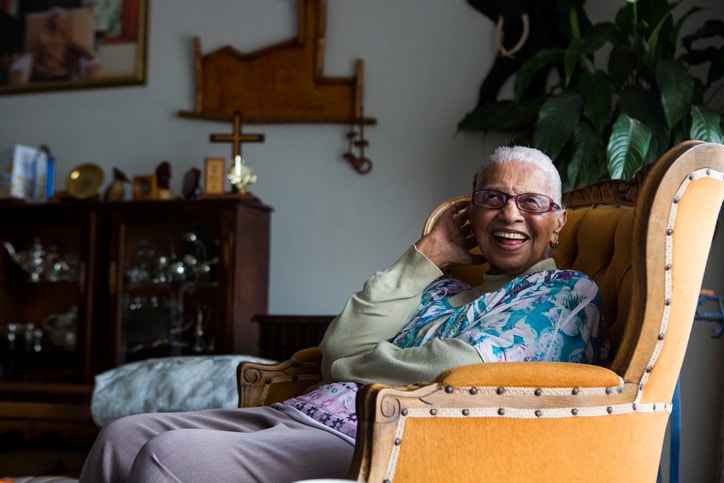In this article
Assessing when and what kind of additional care might be needed for a loved one or client can be tough. Independence can be difficult to gauge, and decline isn’t always apparent.
The six activities of daily living (ADLs) and the eight instrumental activities of daily living (IADLs) can be helpful in assessing whether seniors can or should continue living on their own, or if some assistance might be needed. In some cases, insurance companies, including Medicaid, might also want to do an ADL or IADL assessment to verify needs before agreeing to pay for additional care or a nursing facility.
Key takeaways
- Activities of daily living (ADLs) are used to assess whether older adults are able to live on their own or if assistance in some form is needed.
- There are six ADLs, including bathing, dressing and feeding. If older adults can do all of these activities on their own, they’re considered to have “full function.”
- In addition to ADLs, instrumental activities of daily living (IADLs) — such as telephone, laundry and medication management — can also shed light on whether or not an older adult needs assistance.
What are activities of daily living (ADLs)?
ADLs were developed in the 1950s by internationally renowned geriatrician Sidney Katz to help health care providers measure changes in physical function for patients being treated for disabling conditions, such as a broken hip or following a stroke. Katz and his multidisciplinary team wanted to restore patients to as much independence as possible, but to do that, they had to first figure out what “independence” looked like.
They developed a tool to assess things that people do on a day-to-day basis to take care of themselves physically like grooming or using the bathroom — personal tasks that are fundamental to being able to care for yourself on your own.
Defining the six ADLs
- Bathing. Bathes completely by oneself, or needs help cleaning only a single part of the body (ex. back, genitals, or injured/disabled extremity).
- Dressing. Retrieves clothes from dresser or closet and puts them and outer garments on (ex. sweaters or jackets) using the appropriate fasteners. Help may be used to tie shoes.
- Toileting. Goes to the bathroom without help, including getting on and off the toilet, taking off and putting on clothes, and cleaning genitals.
- Transferring. Gets in and out of a chair or bed without assistance, except for perhaps a mechanical transferring aid.
- Continence. Has complete control over urination and defecation.
- Feeding. Transfers food from a plate into the mouth without assistance, though the food may be prepared by another person.
What are instrumental activities of daily living (IADLs)?
While ADLs were helpful in revealing areas of physical disability that might impact independence, there’s of course more to taking care of yourself than just hygiene or grooming. The IADLs were developed in the late 1960s to measure a greater range of activities needed for independence and spot disabilities that might not show up using the ADL scale alone — tasks like managing finances and grocery shopping, which are more complex than ADLs but still necessary to live independently in a community.
Defining the eight IADLs
- Using the telephone. Answers the phone, dials well-known numbers and takes initiative to operate the phone on their own.
- Shopping. Takes care of all purchases without assistance.
- Food preparation. Plans, preps and serves all food needed for meals and snacks.
- Housekeeping. Does light to heavy home maintenance tasks (ex. washing dishes, making the bed) with or without help.
- Laundry. Completes some or all personal laundry.
- Mode of transportation. Manages personal travel independently and/or uses public transportation with or without assistance.
- Responsibility for own medications. Takes the appropriate amount of medication at the correct time without supervision or prompting.
- Managing finances. Handles all or some finances with little to no help, including paying bills, keeping track of income and day-to-day purchases.
Whats the difference bewteen ADLs and IADLs?
| Activities of daily living (ADLs) | Instrumental activities of daily living (IADLs) |
| Bathing | Using the telephone |
| Dressing | Shopping and food preparation |
| Toileting | Housekeeping and laundry |
| Transferring | Managing medications |
| Continence | Independent transportation |
| Feeding | Managing finances |
How are ADLs and IADLs assessed?
ADLs and IADLs can be useful tools to assess independence in loved ones or clients. Keep in mind, though, they aren’t perfect and are generally fluid. What someone needs to be able to do to live or function on their own can vary from person to person, and a person’s physical and cognitive abilities can fluctuate from one day to the next or decline incrementally over time.
Because of this, ADLs and IADLs should be looked at periodically to spot any changes in function and verify that living and care arrangements are still appropriate. If your loved one’s needs are reaching a point where they are exceeding the safety of their living situation, it may be time to consider an assisted living community or other senior living arrangement.
Here’s how caregivers can assess both ADLs and IADLS.
Professional assessments
The Katz Index of Independence in Activities of Daily Living is the most common instrument used to gauge someone’s independence. Older adults are asked whether they can accomplish six different tasks, and one point is given for each activity they can do without any supervision, direction or assistance.
How seniors respond to the assessment can shed light on how much (if any) additional care might be needed. If seniors can do all six activities, they are considered to have “full function,” and can take physical care of themselves on their own. A score of four out of six means they have “moderate impairment” and might need additional care, while two out of six or fewer signals “severe functional impairment” and means they require care.
IADLs are often measured using the Lawton Instrumental Activities of Daily Living Scale, a brief assessment that takes 10-15 minutes to complete. The scale measures to what extent individuals can perform the eight tasks. Like the Katz ADL Index, the Lawton IADL Scale assigns a point value to each answer (0 or 1), and points are tallied to give an overall score ranging from 0 (low function) to 8 (high function). Where someone falls on that spectrum can help families figure out just how much (if any) additional help might be needed.
Caregiver or self-assessment
Because of your proximity as a caregiver, you may notice changes in your client’s or loved one’s abilities sooner than their medical team or even earlier than they notice themselves without doing an official assessment. They may communicate to you — or you may observe — that certain ADLs or IADLs are becoming harder for them.
For many seniors, there’s a general progression for these activities. As they age, harder tasks like bathing tend to become more and more challenging to do independently, while feeding themselves might be one of the last ADLs where they need physical assistance.
What questions can help determine an older adult’s level of care?
In addition to observing your senior loved one or client and performing ADL and IADL assessments, you can also ask yourself and them some questions to get a sense of their level of care needs. Here are some examples.
- Are there household tasks you could outsource that are becoming more difficult (such as doing laundry or cleaning)?
- Is it sufficient to have someone check in regularly (a neighbor or yourself), or would hiring a caregiver lessen everyone’s load?
- How are they handling their medications? Are they getting refilled and taken as instructed?
- Are they able to drive themselves safely or arrange for transportation independently?
- Is maintaining hygiene becoming difficult for them?
How can senior living can help with ADLs?
Periodical ADL and IADL assessments are important for caregivers in order to gauge the safety of clients or loved ones that are living on their own. If your loved one is showing signs that they may benefit from assistance with IADLs and ADLs, it might be worth considering a senior living solution, such as assisted living.
On a practical level, you can expect assisted living community services to include assistance with both IADLS and ADLs — such as providing meals, helping with housekeeping, assisting with bathing and managing medication. This kind of support can allow your loved one to live with greater independence for longer.
With additional reporting by Elise Ramsbottom.





